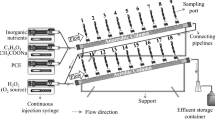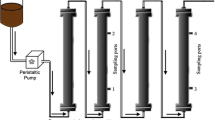Abstract
This paper discusses natural attenuation of chlorobenzene (CB) elimination in a deep confined aquifer in a certain test site in China during a groundwater artificial recharge process. Pilot-scale experiments were conducted in laboratory, including adsorption and biodegradation experiments. The results from the adsorption experiments indicated that the adsorption rate increased within the temperature range 0–20 °C. Processes were fitted to the pseudo-first-order and pseudo-second-order kinetic equations, Freundlich and Langmuir models. Maximal amounts of adsorption were 20.747, 21.505 and 23.364 µg/g at 0, 10 and 20 °C, respectively. The adsorption of CB was an endothermic process. The results from the biodegradation experiments indicated that the processes were well fitted by the Monod and first-order decay kinetics equations at different temperatures. It showed that the Monod μ max changed from 0.0314 to 0.0387 h−1, and the half-life (t 1/2) decreased from 3.02 to 1.46 d with an increase in temperature from 0 to 20 °C. The influence of temperature on the biodegradation rate was expressed by the Arrhenius equation. This study provides information on the mechanisms of natural attenuation of CB in the subsurface environment, whilst also providing the necessary technical information for the security of artificial recharge implementation.







Similar content being viewed by others
References
Andrzej C, Jerzy S (1980) The adsorption of chlorobenzene on the gold electrode. Electrochim Acta 25:1313–1316
Bruce R, Perry M (2002) Environmental biotechnology: principles and applications. McGraw-Hill Companies Inc, New York, pp 128–135
Brunsbach FR, Reineke W (1994) Degradation of chlorobenzenes in soil slurry by a specialized organism. Appl Microbiol Biotechnol 42:4125–4420
Cornelissen G, Hassell KA (2000) Slow desorption of PCBs and chlorobenzenes from soils and sediments: relations with sorbent and sorbate characteristics. Environ Pollut 108:69–80
Gerd UB, Heidrun P (2009) Pulsed gas injection: a minimum effort approach for enhanced natural attenuation of chlorobenzene in contaminated groundwater. Environ Pollut 157:2011–2018
Guo Y, Li Y (2010) Effects of activated carbon properties on chlorobenzene adsorption and adsorption product analysis. Chem Eng J 236:506–512
Jiang J, Zhang R (2007) Simultaneous biodegradation of methyl parathion and carbofuran by a genetically engineered microorganism constructed by mini-Tn5 transposon. Biodegradation 18:403–412
Kloprogge JT, Korbijn L, Koster TM (1997) Head-space gas chromatography, a quick and simple method to screen adsorption capabilities of porous materials: adsorption of chlorobenzene on modified montmorillonite. Appl Clay Sci 12:85–91
Lee S, Pardue JH, Moe WM (2009) Effect of sorption and desorption-resistance on biodegradation of chlorobenzene in two wetland soils. J Hazardous Mater 161:492–498
Li L, Peters CA, Celia MA (2006) Upscaling geochemical reaction rates using pore-scale network modeling. Adv Water Resour 29(9):1351–1370
Li L, Peters CA, Celia MA (2007) Applicability of averaged concentrations in determining geochemical reaction rates in heterogeneous porous media. Am J Sci 307:1146–1166
Loannis P, Dimitrios K (2006) Influence of soil physicochemical and biological properties on the degradation and adsorption of the nematicide fosthiazate. J Agri Food Chem 54:6783–6789
Long C, Li Q (2010) Adsorption characteristics of benzene–chlorobenzene vapour on hypercrosslinked polystyrene adsorbent and a pilot-scale application study. Chem Eng J 160:723–728
Magdalena VM, Jose RE (2005) Degradation of chlorobenzenes by a strain of acidovoraxavenae isolated from a polluted aquifer. Chemosphere 61:98–106
Malzer HJ, Gerlach M, Gimbel R (1993) Effects of shock loads on bank filtration and their prediction by control filters. Water Supply 11:165–177
Menard C, Ramirez AA (2012) Effect of trace gases, toluene and chlorobenzene, on methane biofiltration: an experimental study. Chem Eng J 204:8–15
Mohamed M, Hatfield K (2005) Modeling microbial-mediated reduction using the quasi-steady-state approximation. Chemosphere 59:1207–1217
Mohamed M, Hatfield K (2011) Dimensionless monod parameters to summarize the influence of microbial inhibition on the attenuation of groundwater contaminants. Biodegradation 22:877–896
Mohamed M, Hatfield K, Hassan AE (2006) Monte Carlo evaluation of microbial-mediated contaminant reactions in heterogeneous aquifers. Adv Water Resour 29:1123–1139
Nishino SF, Jim CS, Charles AP (1994) Biodegradation of chlorobenzene by indigenous bacteria. Environ Toxicol Chem 13:871–877
Paul S, Boric H, Worth E (2001) Investigations of the relevance of aliphatic amines for drinking water production from Elbe riverbank filtrate. VomWasser 96:29–42
Qi C, Li F, Li Y (2010) Adsorption characteristics of benzene–chlorobenzene vapour on hypercrosslinked polystyrene adsorbent and a pilot-scale application study. Chem Eng J 160:723–728
Reineke W, Knackmuss HJ (1984) Microbial metabolism of haloaromatics: isolation and properties of chlorobenzene-degrading bacterium. Appl Environ Microbiol 47:395–402
Ribes J, Keesman K, Spanjers H (2004) Modeling anaerobic biomass growth kinetics with a substrate threshold concentration. Water Res 38(20):4502–4510
Sennour R, Mimane G, Benghalem A (2009) Removal of the persistent pollutant chlorobenzene by adsorption onto activated montmorillonite. Appl Clay Sci 43:503–506
Strigula N, Detteb H, Melasc VB (2009) A practical guide for optimal designs of experiments in the Monod model. Environ Model Softw 24(9):1019–1026
Turlough FG (2008) Ex-situ bioremediation of chlorobenzenes in soil. J Hazard Mater 154:9–20
USEPA (1995) OPPT chemical fact sheet-chlorobenzene fact sheet (CAS No. 108-90-7) U.S. Environmental Protection Agency, Washington, DC
Van der Meer JR, Werlen C, Nishino SF (1998) Evolution of a pathway for chlorobenzene metabolism leads to natural attenuation in contaminated groundwater. Appl Environ Microbiol 64:4185–4193
Wang C, Xi J (2008) Biodegradation of gaseous chlorobenzene by white-rot fungus phanerochaete chrysosporium. Biomed Environ Sci 21:474–478
WHO (2003) Chlorobenzene (Environmental Health Criterion 169). WHO, Geneva
Xu J, Chen WP, Wu LS (2009) Adsorption and degradation of ketoprofen in soils. J Environ Qual 38:1177–1182
Yu J, Molstad L, Frostegard A, Aagaard P, Breedveld GD, Bakken LR (2007) Kinetics of microbial growth and degradation of organic substrates in subsoil as affected by an inhibitor, benzotriazole: model based analyses of experimental results. Soil Biol Biochem 39(7):1597–1608
Zhang W, Lin X, Su X (2010) Transport and fate modeling of nitrobenzene in groundwater after the Songhua River pollution accident. J Environ Manag 91:2378–2384
Zhao X, Yang G, Wu P, Li N (2001) Studies on the adsorption of chlorobenzene on marine sediments. J Colloid Interface Sci 243:273–279
Zheng S, Yang Z (2004) Removal of chlorophenols from groundwater by chitosan sorption. Water Res 38:2315–2322
Acknowledgments
The research was financially supported by National Natural Science Foundation of China (41103045, 41472215). The authors would like to thank the journal editors and the reviewers for their comments which helped to improve the paper considerably. We are also thankful to the staff at Shanghai Institute of Geological Survey for their assistance in the field.
Author information
Authors and Affiliations
Corresponding author
Rights and permissions
About this article
Cite this article
He, H., Yu, X., Huan, Y. et al. Natural attenuation of chlorobenzene in a deep confined aquifer during artificial recharge process. Int. J. Environ. Sci. Technol. 13, 319–326 (2016). https://doi.org/10.1007/s13762-015-0864-4
Received:
Revised:
Accepted:
Published:
Issue Date:
DOI: https://doi.org/10.1007/s13762-015-0864-4




